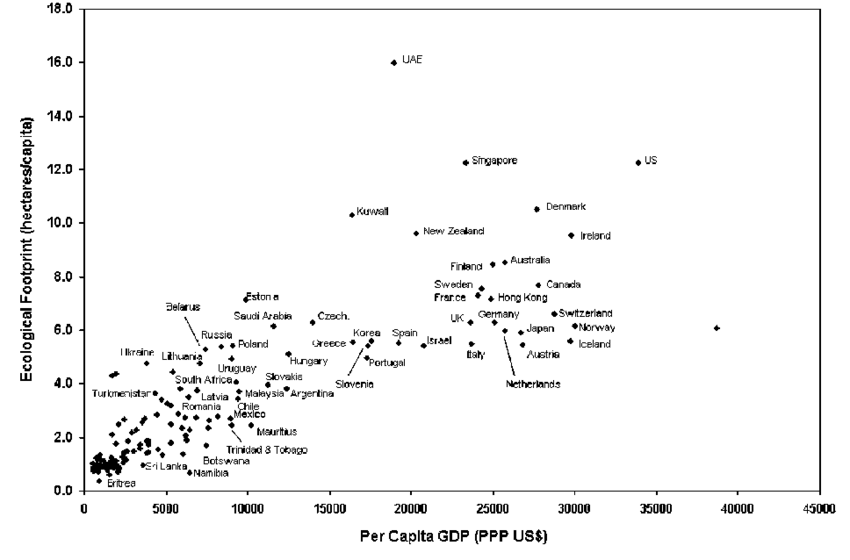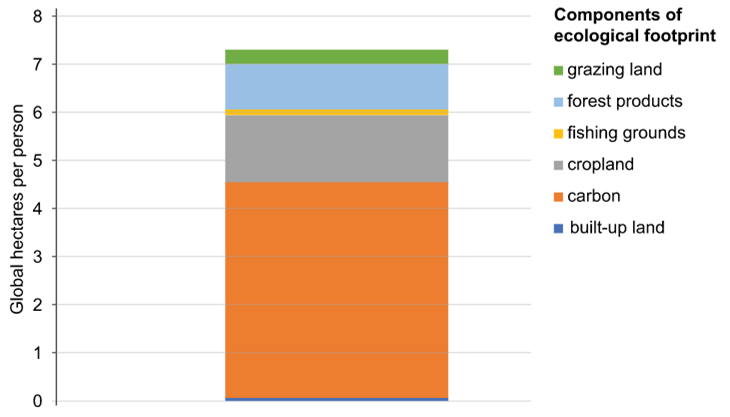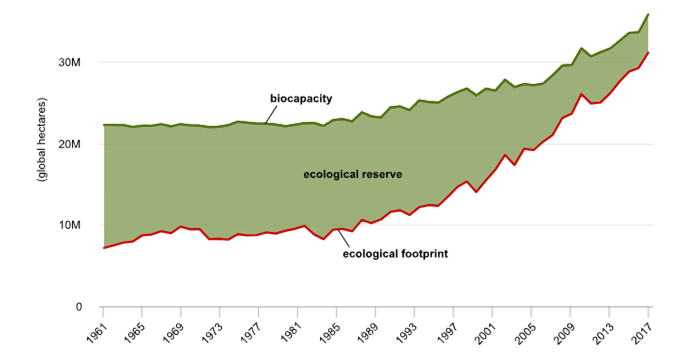Ecological footprint
The ecological footprint (EF), is a measure of the demands made by a person or group of people on global natural resources. It has become one of the most widely used measures of humanity’s effect upon the environment and has been used to highlight both the apparent unsustainability of current practices and the inequalities in resource consumption between and within countries.
What on earth is the ecological footprint?
Your EF is a way to measure the land and resources required to sustain you.
Think of it this way: everything you use, consume, or do has an impact on the environment. The food you eat, the clothes you wear, your transport and energy use and the wastes you produce. The EF calculates the amount of land and resources , the ecosystem services, that make this possible.
People with smaller footprints are said to be living more sustainably, using renewable energy, reducing waste and consuming less.
To do: EF introduction [EF Key points download]
Complete the following definitions
Ecological footprint (EF)
Global hectares (gha)
Label diagram that explains the ecological components of the EF calculation.
List the ways people can reduce their EF
Measure your own footprint at the Footprint calculator (Screenshot the results for later use)
Explain the EF to me like I am an examiner who is unsure about giving you a good mark.
Describe the relationship between a country's population, its biocapacity and its EF using the examples of an ecological debtor and reserve country.
1. Biocapacity
Biocapacity Earth's ability to sustainably provide resources and absorb waste. It is the planet's budget for ecosystem services. Biocapacity is a measure of the earths finite capacity to provide resources and absorb wastes. Biocapacity declines as ecosystems decline and their ability to provide services (provisioning, regulating supporting) is reduced.
EG If humans cut down trees faster than they can grow back, use water from rivers and lakes faster than they can be replenished, or emit more waste than natural processes can absorb. Biocapacity will decline as ecosystems start to degrade. Understanding biocapacity helps to make informed decisions about managing ecosystems sustainably. It's like balancing an account - you can only spend what can be sustainably regenerated and absorbed. By staying within Earth's biocapacity limits, ecosystems can continue to provide services.
The earth has 13.4 billion hectares of biologically productive land and water, we have 1.8 gha (Biocapacity) each.
To do: Biocapacity questions
Complete the following definitions
Biocapacity
Ecological reserve /creditors
Ecological deficit / debtor
Annotate a graph and a map of global biocapacity.
Explain why Australia with an EF per capita of 8.2 is a creditor country and India with an EF per capita of 1.5 is a debtor country.
EF Revision
Exam questions.
Refer to the graph. Describe the relationship between GDP and the EF (2)
Refer to the map. Explain the difference between an ecological creditor and an ecological debtor country. (4)
3. Explain two strategies that an individual could adopt to reduce their ecological footprint.
Each strategy must address a different component of the EF (4)
Case Study: Reforestation in Mali
More than 80% of Mali's land is desert or semi-arid. Mali faces serious environmental challenges from desertification and deforestation. Average annual tree cover loss is about 180 hectares.
The Great Green Wall Initiative aims to create a mosaic of green and productive landscapes 7775 km across northern Africa with a total area of 662 500 hectares
Initially conceived to combat desertification and to stop the Sahara Desert from growing the program has evolved into a program promoting water-harvesting techniques, greenery protection, and optimised land use.
4. Suggest reasons for the total ecological footprint for Mali increasing since 1985. (2)
5. Suggest reasons for the total biocapacity for Mali increasing since 1985. (2)
6. Is Mali an ecological debtor or creditor? (2)



